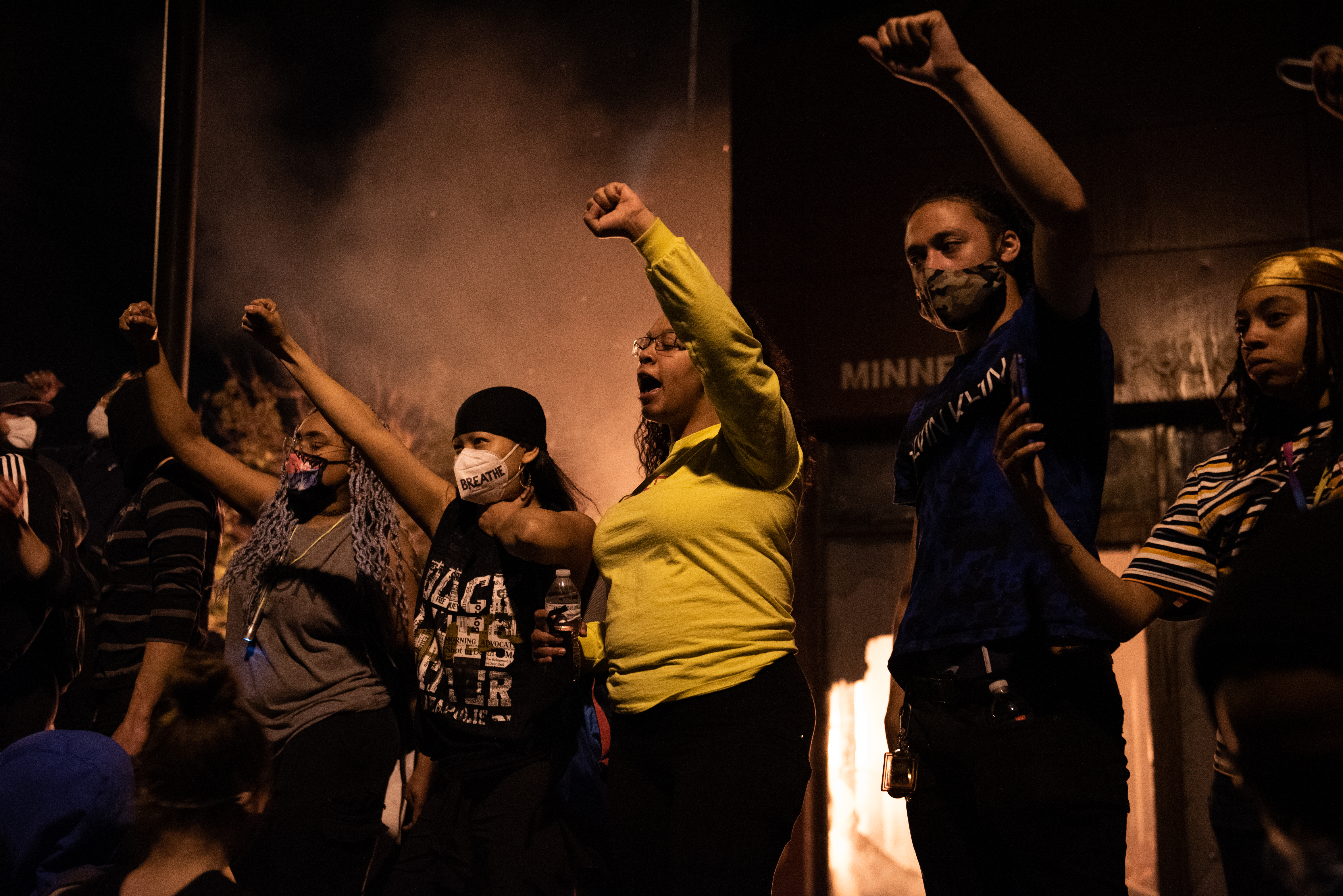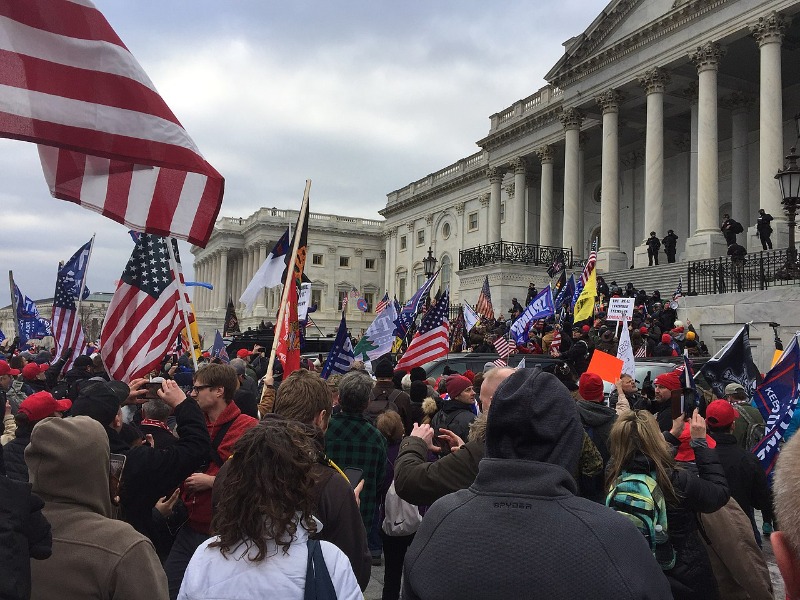The Flood of Online Misinformation Around the George Floyd Protests
Numerous individuals and groups are posing—both online and in person—as members of groups they oppose. Malign state actors have also begun to enter the fray.

Published by The Lawfare Institute
in Cooperation With

Over the past few weeks, the streets of American cities have been filled with protestors justifiably angry about the murder of George Floyd and the larger pattern of police violence against black Americans. Likewise, our social media feeds have been flooded with photos and videos that range from the horrifying to the uplifting. Amid the clarity of the message that black lives matter, though, this unrest has caused confusion at the margins. When a protest becomes violent, it isn’t always clear who has precipitated the shift. Far-left extremists, protestors, far-right white supremacists and law enforcement officers (who have in some cases removed their identification tags) are all potential perpetrators.
And in this moment of complexity and partisanship, many Americans are eager for shortcuts that simplify the narrative. It is tempting to look at a picture of people at a protest or riot and conclude—based on their skin color, clothing or the signs they are holding—what political affiliation they might have and if they’re to blame for violence. The reality, though, is that these shortcuts don’t work—especially today, when numerous groups are setting up social media accounts in the name of groups they oppose, clothing themselves to look like the “enemy,” and spreading rumors about imminent attacks that have not actually been planned by anyone. Social media surrounding the protests has transformed into a hall of misinformation mirrors, and skepticism is required.
In early June, for example, Twitter removed multiple accounts run by a white supremacist group (known as Identity Evropa or American Identity Movement) posing as “antifa” (shorthand for “anti-fascist”). One of the fake accounts (@Antifa_US) called for violence in support of the Black Lives Matter movement—a message that was amplified when Donald Trump Jr. shared a screenshot of @Antifa_US’s with his 2.8 million Twitter followers as evidence that antifa was violent and dangerous. While Trump Jr. likely acted without realizing that the account was fake, his tweet radically increased the influence of Identity Evropa’s disinformation campaign. In another instance, a number of known white supremacists, members of the Proud Boys, were photographed at protests in Portland wearing the all-black clothing typically associated with antifa groups.
There is no definitive answer to why Identity Evropa/American Identity Movement made these fake Twitter accounts, but it seems likely that the goal was to sour public opinion towards antifa and cast the movement as violent. The reasons why white supremacists may dress like antifa activists are harder to guess. It’s possible they were planning to be violent and hoped that people would blame antifa, but it’s also possible they were hoping to blend in with the crowd of protestors.
Similarly, confusion has spread about supposed imminent attacks by busloads of violent antifa terrorists. According to The Verge, one fake story published on Facebook claimed that a small town in Illinois had been chosen as one of the targets for antifa’s alleged imminent attacks because “restrictions on gun ownership have ‘transformed the state into a shooting gallery for Antifa terrorists.’” It’s not clear who wrote the post, but the language suggests that the authors of these rumors might actually be gun-rights activists or someone pretending to be such activists. Even more confusingly, the rumors were reportedly originally spread by a far-right anti-vaccination group that previously had been banned from Facebook. While the post itself aligns with the group’s far-right political agenda, it isn’t clear why an anti-vaccination group was spreading disinformation that might provoke violence.
It may be that not just individuals but also state actors have been or will become involved in the chaos. Based on Russia’s involvement in promoting racial tensions prior to the 2016 U.S. presidential election, sometimes with the aim of persuading black individuals not to vote, it makes sense that Russia, or other malign actors, will find a way to exploit this polarized moment. We already know that openly Russian and Chinese accounts (for example, state-backed media outlets and government officials) have been posting extensively about the protests in an effort to amplify the spread of divisive materials. If they’re doing so openly, it is easy to imagine that they may be doing so covertly as well.
Consider another example. On May 31, a reporter tweeted that the Pittsburgh police were looking for an individual named Brian Bartels on suspicion of inciting riots. A photograph of Bartels was posted to Twitter. He was wearing a black bandana with a very clear “A” symbol, and someone replied claiming that this was the symbol of the Animal Liberation Front (ALF). The subtext was clear: The bandana could tell readers what side Bartels was on, and from the symbol they could conclude that he was a left-wing extremist (though oddly, they were to assume he was an environmental terrorist).
As scholars of terrorism, this struck us as highly unlikely. First, the “A” on Bartels’s bandana was made with two assault rifles leaning against each other. The more standard version of the ALF logo is an “A” made from a pair of open bolt cutters (symbolizing the liberation of animals from cages). And second, the Animal Liberation Front has largely pursued a narrow agenda and the list of its usual targets (farms, fast food restaurants, recreational hunting organizations and the like) is consistent with its mission not to harm any living thing. It’s easy to imagine that many ALF members might have separate political commitments that would compel them to join in the protest of George Floyd’s murder, but it’s harder to imagine that a member of the ALF, whose mission denounces violence against both people and animals, would incite rioting during these events.
It turns out that a bandana looking very much like Bartels’s is being sold on Amazon by a company called Chat Noir. The listing on Amazon describes the bandana as “Animal Liberation Front (ALF) Bandanna - Vegan Vegetarian Rights Welfare Anti Authority Anarchy Human Testing Meat is Murder Social Political Class War Activism Anarchism Anarcho Punk Earth Head Scarf.”
There was no way to know from the image of the bandana whether or not Bartels belonged to the ALF. If Bartels actually purchased the bandana currently being sold on Amazon, it’s impossible to know which part of the ideologically incoherent description appealed to him. It’s also impossible to know if he even read the description, or if he purchased the bandana because it was black, it looked militant, or because it had an “A” on it (perhaps suggesting antifa). And even more confusingly, there is no way to tell from the picture if Bartels identifies with an extremist movement on the left (be it the ALF or antifa) or if Bartels is a far-right white supremacist posing as someone from the left (likely antifa).
Relying on identity markers such as clothing or symbols to determine someone’s ideology has always been a foolish shorthand. But it is especially so today, when psychological operations by terrorists and others are in full swing. The reality is that there are no reliable visual markers of ideology. Not race or ethnicity, not the slogan on a sign, and not the symbol on a bandana.
Reports now indicate that Bartels, who is facing federal charges accusing him of rioting and inciting violence, identifies with the far left. Some people will have guessed this correctly, and they’ll interpret the evidence as affirmation of their shortcut. But they will simply have been lucky.
It is hard to tell to what extent this confusion is manufactured—an intentional effort to take advantage of current fears and political polarization. In some cases, like the one in which white supremacists from American Identity Movement posed as antifa activists, we know the true identity behind the account and it is clear that the deception is intentional. In other cases, such as the baseless stories of antifa attacking rural towns, it is still unclear who authored the posts. It could have been extremists on the left, extremists on the right or bored teenagers. Not all false information has malicious roots, though, and sometimes it spreads from people who are genuinely confused and looking for answers—as might have been the case with Twitter users guessing at Bartels’s political affiliation. Sometimes, it’s impossible to tell.
In the midst of this chaos, it is critical that people refrain from drawing too-easy conclusions about alleged extremists. There is no benefit to these kinds of shortcuts, and there is significant potential for harm. These too-quick judgments, and overconfidence in the truth of material posted online, make onlookers vulnerable to manipulation and misinformation. And this vulnerability can result in confrontations that don’t need to happen. In some ways, Americans have been lucky so far, but it’s possible—even likely—that at some point a misunderstanding that begins online will lead to a conflict in which someone is injured or killed.
Moreover, focusing on the actions of extremists of any political affiliation distracts from the integrity of these protests. Every time Americans indulge in speculation about these peripheral actors—whether leveraged by ordinary citizens, or foreign adversaries, or members of the First Family—they allow themselves to be distracted from a legitimate and urgent social issue. The better approach is to keep attention on the central concern motivating this movement—a legacy of racial discrimination that threatens the lives of black Americans.




.jpeg?sfvrsn=6117c6bf_4)
